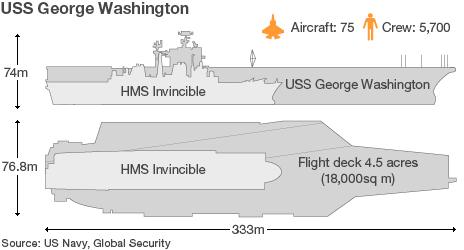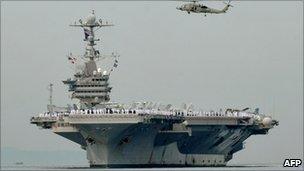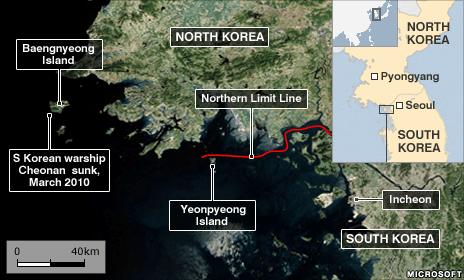The Korean crisis and US carrier diplomacy
- Published

The nuclear-powered aircraft carrier USS George Washington and its escorts are heading for the waters off the Korean peninsula, in the aftermath of the flare-up between North and South Korea. This is very much gunboat diplomacy 21st Century-style.
Indeed, the George Washington has already been deployed there this year, following the rise in tensions after the sinking in March of the South Korean warship Cheonan - widely blamed on the North.
Then, as now, it was to send a series of messages - supposedly of reassurance to the South, and deterrence to the North.
It is a move that the United States has made many times in response to crises during the Cold War and since.
In many ways, the US fleet of aircraft carriers has been as much a diplomatic instrument as a military tool. The US Navy proudly boasts that in virtually every crisis, the first question every US president asks is: "Where is the nearest carrier?"

The USS George Washington has experience in the waters off the Korean peninsula
For example, the United States deployed the nuclear-powered carrier USS Enterprise to the Bay of Bengal as a show of strength during the Indo-Pakistani war in 1971.
Similarly, a US carrier was sent to the waters off Libya in 1981 in a stand-off, and two US fighters actually shot down two Libyan combat planes.
In 1996, at a time of tension with Beijing over Taiwan, President Bill Clinton despatched two aircraft carriers to the region.
And throughout the 1990s, during various flare-ups with the Iraqi leader, Saddam Hussein, Washington signalled its seriousness by how many carriers it dispatched to the Gulf - on occasions, as many as three.
Carrier envy
No other country has a carrier force like the Americans have.
And whenever you go aboard a US carrier, there is almost always a moment when you'll be talking to the captain on the bridge.
He'll expansively wave a hand in the direction of the huge flight deck and make some remark about it being four acres of sovereign US territory that can be parked off any shore to send any message that Washington wants to send.
For that reason, emerging powers like India and China are thinking seriously about building up carrier forces of their own.
But will Pyongyang get whatever message Washington is sending in that direction?
It did not seem to the last time the George Washington was deployed.
And will it be enough to reassure Seoul?
There are other sensitivities as well. Beijing has already complained about this deployment, as it did the last one, which then led to a change of plan about where exactly the George Washington operated.
In a time of growing strategic competition between the United States and a rising China, the US carrier force in the Pacific is an important symbol.
It is a signal of US determination to maintain a presence.
At the same time, there is a heated debate over the significance of China's moves to develop a ballistic missile designed specifically to target carriers.
It also explains why there was consternation in Washington when a Chinese submarine unexpectedly surfaced close to a US carrier strike group on exercise south of Japan in 2007.
